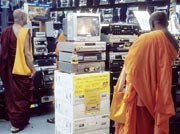
Better Off
The UK government’s Energy White Paper to be published in March will contain new figures on the nation’s use of the standby button. It’s not good news. The figures show that there has been no reduction in the overall amount of energy consumption on standby, still lingering at 8-10% of total electricity use in the home.
If anything there has been an increase in the amount of appliances left on standby, but they have become more energy efficient in the two years since the last survey, so the overall position will be roughly the same according to researchers working on the report.
In fact, we probably won’t see a marked improvement for another 3-4 years while the EU works to legislate against energy-wasting consumer appliances. The problem is that, despite new ways of programming devices to automatically switch into a lower power mode when not in use, the number of appliances we ‘need’ is increasing, too and with it, the cost to the environment.
The worst culprits, it seems, are the current crop of set-top satellite and cable boxes that are left “on” constantly, even when TVs are switched off or left on standby. These are permanently energised in order to be able to receive updated software at any time. Similarly for digital video recorders that can respond to instructions to record instantly. And while surround sound and home theatre systems aren’t in every household, they will contribute considerably to standby waste in individual homes.
The Market Transformation Programme (MTP), a government-funded programme that does research into limiting the environmental impact of products, has produced the most comprehensive survey on standby usage to date (figures from 2004) to estimate the average amount of electricity used up in standby mode by various appliances. The EU’s Standby Initiative have also conducted research into standby use this year, though both sets of data are riddled with guesstimates. Below are the average figures (in watts) for each appliance:
Microwave 2.4
Electric oven 1.7
Domestic laptops, desktop PCs & servers 5.5
Domestic PC monitor 3.6
TV 4.7
Video recorder 4.6
Set top box (satellite/cable) 16.8
Broadband 7
Mobile phone charger 1
Compact hi-fi 9.4
Video games 13.5
Home security system 9.6
Washing machine 3.2
Small kitchen appliance 1.8
Dryer 2
Modem 5.1
Coffee maker 0.8
Dishwasher 2.3
Air conditioning 0.9
Speakers 3.3
Hand held vacuum cleaner 3.7
It seems that new appliances are getting the better of their standby waste. For instance, the Standby Initiative’s figures say that an old TV would have had 6W’s worth of standby consumption compared with 2W for a new TV set. Similarly for VCRs and hi-fi’s, which have lowered their standby figure from 8W to 3W, and 3W to 1W, respectively.
As a percentage, we are told that standby takes up 8% of our total energy consumption, and we can see from the figures that some of them are by no means negligible. In fact, the italicised figures represent data that has a large uncertainty. Part of the problem is knowing how long appliances are left on standby and these figures only take 1 hour of standby a day into consideration. It is likely that some of them would be at least doubled. And, of course, the cumulative effect must not be underestimated. A few phone chargers, kitchen appliances, hairdryers there are just so many things to forget about.
Yes, standby is a significant problem when it comes to wasting energy; but it’s only 8% of the problem. The idea of “good standby” is probably one that will come to be seen as a way of saving energy rather than wasting it in the future. For instance, a PC left “on” for days is better off in standby mode though perhaps even better off, switched “off”. But initiatives to stop domestic energy wastage are tending to concentrate on the producer rather than consumers after all, can you really persuade someone to switch their PC off when we rely on them so heavily? Developing devices that are more energy efficient is the aim of initiatives such as the International Energy Agency’s “1 Watt” programme, but are they are letting us off the hook?
Well, not exactly. While standby usage has been widely reported on, changing attitudes in other spheres – such as using renewables – is more important, says MTP researcher Kevin Lane. It’s seen as more cost-effective to enforce regulations upon manufacturers rather than consumers on standby, but there are plenty of other things for us to be getting on with.